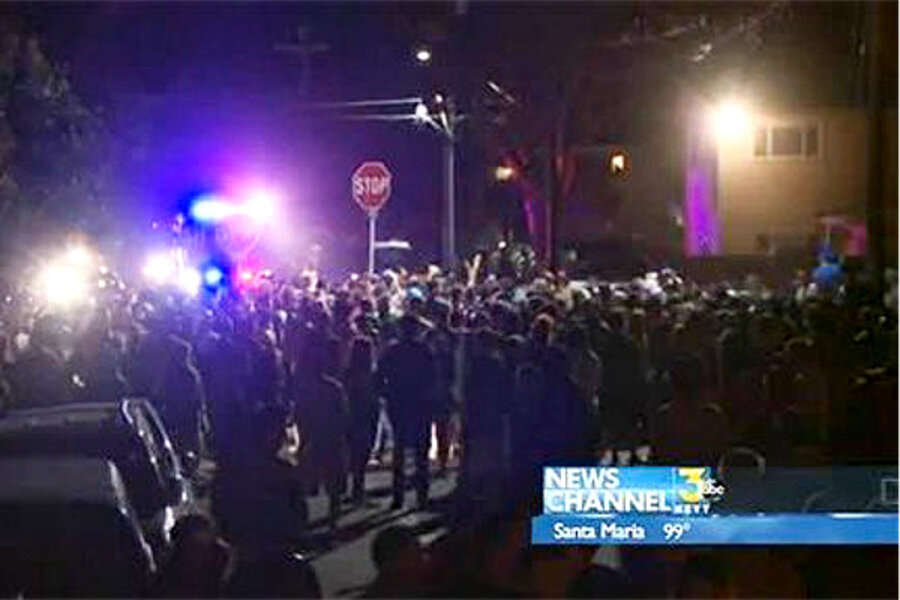Santa Barbara riot: Police blame social media, but was it underutilized?
Loading...
| Los Angeles
As Santa Barbara recovers from a weekend of violent encounters between police and spring-break partygoers, local law enforcement are pointing to social media as one of the major causes for the melee.
Twitter and Facebook chatter helped draw more than 15,000 people to the small Isla Vista neighborhood adjacent to the UC Santa Barbara campus for the neighborhood’s annual spring break celebration. Fires were set, police were attacked, and more than 100 were arrested.
“Social media helped push this event from somewhere around eight-to-ten thousand people up to 15-to-20 thousand,” says Kelly Hoover, spokeswoman for the Santa Barbara Sheriff Department. While the event began decades ago as a spring break beach party, the revelers have been banned from the waterfront since 2009 and limited to parties at individual residences.
But while social media have been transforming neighborhood events from small gatherings to large and occasionally lethal flash mobs for years, increasingly police are using the same social media tools to upgrade their preparation and enforcement strategies.
“There is so much electronic chattering now that social media has expanded the eyes and ears of the police,” says Tod Burke, professor of criminal justice at Radford University in Radford, Va. When officers monitor social media, he says, they are looking for clues about what is happening in the community. And now, he points out, “everyone has a camera, so not only can they hear about what is going on, but they can see it as well.”
The Santa Barbara Sheriff Department did in fact monitor the buildup to the event on social media, says Ms. Hoover, and sent out a call to more than a dozen neighboring law enforcement agencies to send extra personnel once the scope of the turnout had become clear.
In the case of extreme looting and violence, officials have pushed to shut down social media, as was the case after the London riots in 2011. Prime Minister David Cameron suggested that anyone suspected of using a phone to plan criminal activity have service shut down. San Francisco’s Bay Area Rapid Transit shut down cell phone service after phone users organized a flash mob protest on one of its train platforms. The group was protesting a controversial police shooting.
But authorities face a delicate balance in cracking down on social media. In Isla Vista, the social media conversation provided the platform for a dialogue between residents and authorities. Since 2009, loud music has been banned during the annual celebration. The sheriff’s department was able to remind residents and students about this ban using social media. While students took to Twitter and Facebook to complain about the ban, at least it was a way for law enforcement to get the message out broadly into the community.
“In the old days, police used to have to rely on very old methods such as going door to door, or getting local TV or radio to broadcast a message,” notes Professor Burke, but there was no way for law enforcement to know if the message was received.
Certainly, social media can be useful in tracking criminal suspects, even using such tools as facial recognition software on the social media landscape that is awash in citizen photography. Threat assessment is a tougher nut to crack, because one can’t believe everything someone says or posts on social media, points out former FBI agent Frank Scafidi, who now works with the National Insurance Crime Bureau in Sacramento.
However, he says, enough people chattering about something, “can move it from possibility to probability and that can be very helpful.”
A former LA County police officer, Mr. Scafidi adds with a laugh that it shouldn’t take social media to tell police that the well-known Isla Vista spring break party might get out of hand. War stories about the need to import backup law enforcement from surrounding areas to quell unruly spring break partying in Isla Vista date back to the early 1970s, he says.
Indeed, the fact that the situation spiraled out of control in Santa Barbara suggests to some that law enforcement could do a better job using information gleaned from social media, says Peter LaMotte, Senior Vice President at LEVICK, a Washington-based, crisis management firm. “It’s really easy for police these days to get a lot of information right on their laptops, but they don’t always do a great job ensuring that information makes it out to the people on the front lines in the field,” he says.





